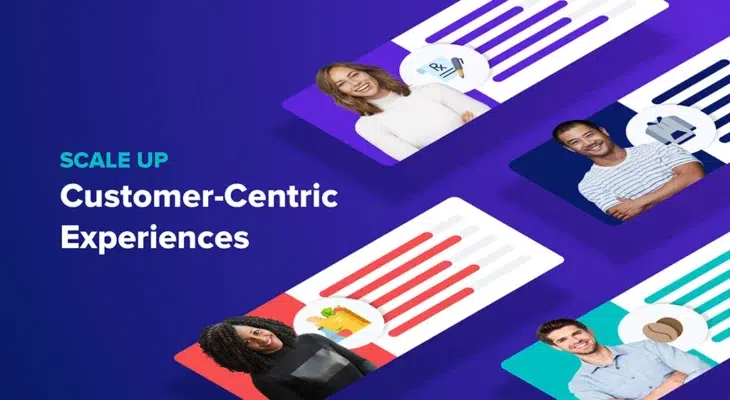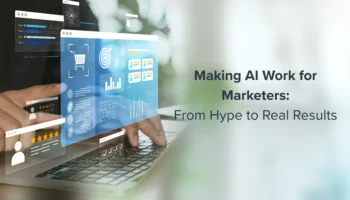I see some version of the tweet below at least every week — and it asks an important question. As the number of brands coming online increases at a staggering rate, online ad spend grows, and that budget is increasingly concentrated on Facebook and Google — paid customer acquisition and retention costs on these channels will likely continue their steady rise.
How Growth Marketers Can Scale Up Customer-Centric Experiences

Meanwhile, customer data privacy regulation is in full swing. Data privacy laws have been enacted in the US (i.e., CCPA) and internationally (i.e., GDPR), Facebook shut down third-party data for targeting ads in 2018, and the most popular web-browsers (Chrome, Safari, Firefox) have started blocking third-party cookies. Successful brands need to reduce their reliance on third-party data and focus their attention on first-party customer data, which is collected with trust and transparency directly from their audience.
At the same time, Marketers should take advantage of the growing number of channels available to them to build trusted and personalized relationships with their customers. In this guide, we’ll cover noteworthy trends for consumer marketers and the first-party customer data opportunity present to marketers. Finally, we’ll bring it all together with how you can collect and unify customer data, apply intelligence, and cross-channel marketing automation to deliver intelligent customer engagement at every touchpoint.
Noteworthy marketing trends
Every brand today has more customer data than ever before. Consumers today engage with brands across more channels than ever before. Meanwhile, every time someone clicks, swipes, adds a product to cart, subscribes, loads up your app, wish-lists, or purchases, they’re leaving behind a rich trail of data through those behaviors.
You can engage your customers on more channels than ever before. More channels are becoming people addressable, which means there are more avenues where you can bring your customer data alive.
Customers expect a personalized and painless experience. ‘Dear Valued Customer’ doesn’t cut it anymore. The best brands today offer deeply personalized experiences and make it incredibly easy for people to engage and transact. 70% of what people watch on YouTube is determined by its recommendation algorithms. More than 80% of the TV shows people watch on Netflix are discovered through the platform’s recommendation system (as of 2017). From 1-Click ordering to Dash Buttons to two-day shipping, Amazon and other leading e-commerce brands want to make the shopping experience as convenient as possible. At Blueshift, we analyzed over 2 billion email engagement data points and found that emails with dynamic product recommendations drove 2x higher click rates and click to open rates (CTOR) compared to static emails.
“Our personalization enables us to create more than 250 million tailored experiences to delight each user every single time they enter the platform.” – Todd Yellin, VP Product & Personalization at Netflix
This is all good news – your customers are leaving behind a rich data-trail and you have more channels where you can onboard your first-party data to deliver more relevant experiences. If you do this well, they will engage and convert with your brand, thereby leaving behind more data.
The first-party customer data opportunity
Many marketers might question whether they have sufficient first-party data. That’s why it is useful to understand that this data can come in many forms, and be collected through various interactions that customers have with your brand. These include:
- Customer-submitted Data (typically captured in a CRM), including customer attributes and demographics, such as name, gender, location, birthday, etc., as well as opt-in preferences and other communication choices.
- Transactional & subscription data, including purchases, upgrades/downgrades, and cancellations.
- Product/content interactions and behavioral data (observed data, gleaned by collecting the customer’s behavior), including page views, swipes, clicks, likes, and “add-to-cart” actions.
- Customer service data, including trouble tickets that have been submitted, resolved, or are still outstanding.
- Marketing interactions, such as opens or clicks of emails and push notifications, as well as views and responses to ads from multiple channels.
- Derived information (gathered by analyzing “metadata,” or patterns, of customer interactions across channels), including identity, location, and customer lifecycle attributes.
In addition, there are tons of channels available to marketers, but here is a shortlist of channels available to onboard your first-party customer data and reach your customers:
- Relationship marketing: Email, SMS, mobile push & in-app notifications, direct mail
- Paid media: Facebook, Google, LinkedIn, Instagram, Pinterest, Snap, TikTok, etc.
- Addressable TV: Freewheel
- Experimentation: Optimizely, VWO
- Customer Service apps: Zendesk, Intercom, Interactive Voice Response (IVR)
This is great news for marketers. With the first-party customer data which you collect with their consent, you now have more avenues to bring this data alive! But, this was not always the case. Even just 10 years ago, customer data was sparse and all we could do was perhaps send a non-personalized newsletter. While some of these channels have existed for a while (TV, SMS, direct mail), many more are now available and more importantly, these channels have become people addressable.
People addressable channels: channels that allow you to reach users based on your first-party data.
This shift is huge! Do you remember how vital Facebook’s Custom Audiences were (and still are) when they rolled out in 2013? That’s now mainstream, but there are now many more channels where you can onboard your first-party customer data and deliver a more relevant experience wherever they are.
Bringing it all together
Step 1 – Full-circle view of the customer
Today, when we talk to brands, the biggest challenge we’re hearing is: how do I make the best of my customer data, really understand who they are, and then deliver customer-centric marketing, not just on email, but how do I do that across all these channels which are now available to me?
The first step to delivering coordinated cross-channel customer experiences is to build a full-circle view of your customer to understand.
Step 2 – Apply Intelligence
Now that you have customer profiles, you can understand each individual on their own but also their preferences in the context of all other customers. You can then apply real intelligence because you know that “Dave G.” has a higher affinity for hoodies relative to your other customers, is likely to purchase within the next 30 days, prefers to be reached via email, and is normally most active on your site at 8 pm.
Meanwhile, “Jenny” has a category affinity for beauty products with coconut oil, prefers to chat and purchase via SMS, and likes to shop during her lunch-hour. Similar to the Netflix quote above, the goal is to implement personalization systems so you can design and deploy the ideal customer experience that scales seamlessly as your customer base and product offering grows and evolves.
Some Marketing tools offer solutions like ‘product feeds and blocks’ to dynamically insert products into an email based on someone’s past purchase behavior. At Blueshift, we think of personalization simplistically as WHO, WHAT, WHERE, and WHEN
- WHO – Predictive scores to automatically identify customers most likely to convert based on past behavior.
- WHAT – Easily create 1:1 product/content recommendations tailored to customers’ interests and behaviors (the Netflix experience).
- WHERE – Channel-of-choice to selectively serve messages based on the user’s channel preference (email, push, SMS).
- WHEN – Communicate to users at the hour of the day they are most likely to engage and convert.
Step 3 – Decisioning
Now that you understand your customers and have personalization systems in place, the final step is applying various decision-making paradigms to execute your communications across relevant channels:
- Journey Flows – For your relationship and life-cycle marketing (welcome series, newsletters, abandon browse, cart abandonment, win-back).
- Live Personalization – Once customers are on your site, serve relevant products and content based on their past behavior with your brand. I.e. the Netflix/Amazon experience.
- Audience Sync – for paid channels, continuously sync your first-party customer segments to paid channels, thereby eliminating manual list uploads for lookalikes, targeting, and suppression. This feature alone has helped Blueshift customers drive down acquisition and conversion costs by over 15% on average while enabling massive workflow efficiencies.
The good news is these three decision-making paradigms are relevant to any channel at every stage of the customer journey. It’s about the customer, not the channel. You’re not making any decisions at the channel level. You’re centralizing all data, intelligence, and decision making at the customer level and treating the channel as a lightweight, thin layer where it’s just an API call to send an email or sync an audience to Facebook. It’s about the customer, not the channel. The goal is to shift from channel-centric to customer-centric experiences.
It’s clear that first-party data, when activated successfully, leads to revenue success. It also allows marketers to be in control of their data, reduce their reliance on 1-2 channels, and start building trusted and personalized relationships with their customers, wherever they are.



